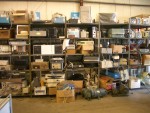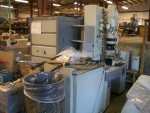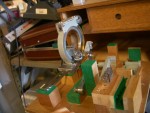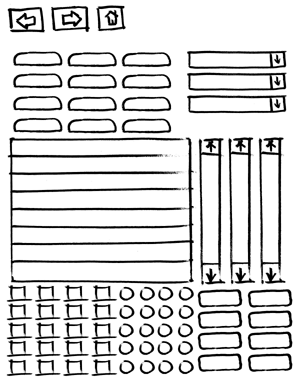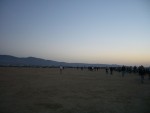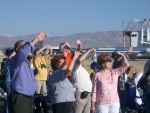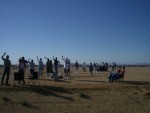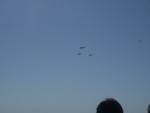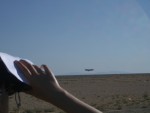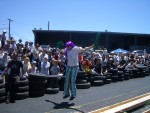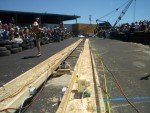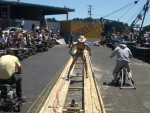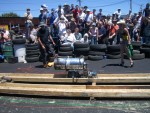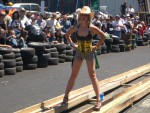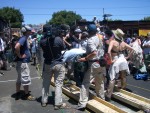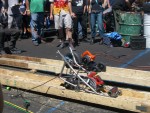January 24, 2005
Cole Whiteman's process diagram language
My old friend Cole Whiteman has been making excellent process diagrams for years. i just noticed that he's put his visual design language online:
It's great to see people so thoughtfully and thoroughly document their notational thinking. We tend to reinvent the wheel whenever making diagrams, or we unthinkingly use the notation provided by our tools (this is at the core of Tufte's argument with PowerPoint), so it's good to see someone who's very good at visual explanation share some of their toolkit. it gives us perspectives on all the others.
Here's a pariticularly complicated and elegant example of Cole's work:
December 31, 2004
When is a salad bowl an ecological statement?
In the IDSA Innovations magazine there's a story by Scott Henderson describing his salad bowl and forks. It's a gorgeous product and a wonderful design, but Henderson devotes a full paragraph describing why it's ecologically sensitive because it's expensive. I find that pretty ridiculous, and it raises all kinds of questions for me, but rather than rant about it, as I'd like to, I'll just reprint it in its entirety:
When designers try to defend their work from an ecological standpoint, they are often forced to search for some spin about the product's material being recyclable. Hence, "the Ensalada is primarily constructed from glass, a natural material that is recyclable and regarded by many as a manufactured material, the use of which is critical to human health and safety because of its ecological properties."All true actually, but the real reason the Ensalada is an environmentally sound product has its basis in something far less scientific--money! The high-end nature of this product contributes to its position as a protector of the environment. It is not a product intended to compete on price, rather it is a special piece that will be displayed with pride and used with care for many years.
Quality is perhaps the factor in the world of design that best protects our environment. The esteemed timepiece company, Patek Phillipe of Switzerland, for example, sells watches for tens of thousands of dollars, in some cases. This successful business is based on the idea that once you own a Patek, you not only own it for life but your children's children also own it because of its extreme quality. The environment will not be damaged on their watch. The Ensalada has a similar goal: to be valued enough by its owners to be passed along to future generations.
OK, maybe I'll rant a bit: so we are absolved from our responsibility for designing ecological products when we make them really expensive. Huh? And since when is the role of a salad bowl to be handed down from generation to generation? It's a day-to-day functional object, and should be designed as such. Quality does not equate to price, and it certainly doesn't equate to protecting our environment. There are lots and lots of high quality excellently designed products that are ecologically unsound (the Coca Cola plastic bottle, perhaps?). Patek Phillipe is a brand based on elitism: do you think that buyers are actually passing those watches down to keep them out of landfills, or is that from an ad campaign designed to help affluent people convince themselves that they need something that is much, much more expensive than any functionality it can possibly deliver?
Environment awareness and long-term thinking are important, maybe even critical, aspects of design. But justifying environmentalism through elitism masked as quality is cynical and ultimately unhelpful.
December 16, 2004
Paste Unformatted
I copy and paste a lot of text from various documents to other documents and it drives me a bit crazy when word processors tend to overhelp and insist on trying to keep formatting. "Paste Special..." is fine, but requires several steps. So I always end up reinventing the same macro, regardless of what word processor or system I'm using. I just got a new Mac and bumped into this problem, and ended up reinvening the macro, so I figured I'd share while I could. At some point I may find the OpenOffice/StarOffice version of this command, and post that. It's the simplest macro ever, but here it is:
Sub PasteUnformatted()
'
' PasteUnformatted Macro
' Macro recorded 12/16/04 by Mike Kuniavsky'
Selection.PasteAndFormat (wdFormatPlainText)
End Sub
To use:
- Go to Tools:Macro:Macros...
- Type in "PasteUnformatted" into the Name field
- Click "Create"
- Paste "Selection.PasteAndFormat (wdFormatPlainText)" into the space where it puts the cursor
- Save
- I then assign it to a command key (I use Command-Shift-V--currently "Paste from Scrapbook," but who cares about the scrapbook?) and give it a toolbar icon (I like the little grey piggy bank) through Tools:Customize:Customize Toolbars/Menus command.
December 10, 2004
The oldest graphics ON THE WEB!
You'll have to exuse me. This is totally self-indulgent, but in doing some research i realized that the very first site I had a hand in designing, the HotHotHot hot sauce store, is still using some of the same graphics that I hand-tuned for it more than 10 years ago, based on drawings by Yeryeong Park. This may make them the oldest continuously-used graphics on the Web, apart from the ones that are built into Apache or something. Woohoo!
Here, you can compare.
The originals:
Its nice to see something be semi-permanent in the ephemeral world of the Web.
November 29, 2004
Carhartt: One brand, two universes
Thanks to my OG Detroit upbringing, I've been familiar with Carhartt clothing for a long time. About 5 years ago I started wearing their dungarees (their term for "work pants") because they fit me better, were a classic design and put me in closer touch with my internal frustrated proletarian laborer. Plus, they look badass. In the US, they're still workers' clothing for the most part: farmers, mechanics, welders, and (in much smaller quantities) greasy Burning Man artists. But in Europe, they've become super chic techno clothing, the physical manifestation of a Roland 303 bassline (all the more appropriate since Carhartt is a Detroit brand, and Detroit's place in the techno mythology of Berlin is huge). After noticing that a lot of their clothing was being shipped to boutiques in Europe and Japan and that it was used as the official hoodie for the last Tricky tour, it looks like someone at Carhartt figured it out and decided to license the name.
Now, knowing that, check out the differences in experience in these two sites:
There's even a boutique in one of the hippest parts of Berlin, complete with graffiti and a Carhartt-branded trick bicycle in the window. Many of my friends there wear Carhartt clothing, but it's nothing like the clothing that the US brand makes.
At first, this seems to be good branding strategy: capitalize on reputation in a market that doesn't provide a lot of revenue by licensing your name to a local. It certainly makes more sense than calling your mayo different names depending on which side of the Mississippi it's being sold on (cf: Hellman's vs. Best Foods; also King Dons vs. Ding Dongs, and snicker if you want to).
Now here's the problem: with such a radical difference, is Carhartt endangering their brand? The coolness of the European brand depends on the stodgy solidity of the US brand, since it's based totally on reference and myth, but the US brand is the bread and butter of the company. Say the European licensee does something stupid, like make a really low-quality product (how good can that bicycle be?) and their name gets trashed in world media. Is that going to completely cause the house of cards to fall, creating confusion among the cash cow US market? Brand resilience isn't infinite. Moreover, fashion being what it is, today's Carhartt is tomorrow's Tommy Gear and next week's Cross Colours. Would being super-duper uncool spill over to the US and if it did, would that be a problem?
I don't know, but it's an interesting question and a good example of brand strategy caught in the wild.
November 09, 2004
More property disposition
Another visit with my family in Michigan means another visit to the University of Michigan's Property Disposition store. I've written about this place before and it's still one of my favorite hometown technology tourist attractions. I decided to take some pictures this time:
The first picture shows shelves of old scientific equipment, the purpose of much of which is lost, maybe to everyone. The third one is a closeup of a piece of measuring equipment that has no manufacturer label, and I have no idea what it's for, but it was probably made before WWII and it is beautifully machined (and it's only $75!). The second picture is of an electron microscope that's only $250, but you have to 1. take it home and 2. figure out how to make it work. Or maybe it can just be a really cool piece of decoration. I'm sure there are some beautiful parts on it. I'd consider buying it, if my parents weren't already on my case for storing that PDP4 in our shed.
Not pictured: the RS/6000 RAID cluster (I guess it's SCSI and had 100 drives in it, adding up to maybe 250GB), $300 (I think), the 1940s Cincinnati lathe ($750), a beautiful IBM mainframe cabinet, with some large mainframe in it ($500?) and an industrial mixer, the most expensive thing I saw because it actually still does something interesting, $1000.
October 25, 2004
Primer: geek porn
Cassidy took me to see Primer, a film that he saw at Sundance, last night. It's an ultra low budget sci-fi film, and geek porn of the first order. It's a classic sci-fi story, one that could have been written in the 50s, but the context is interesting. It's set the world of startups, venture capital, technology parks and day trading. Classically, the ultimate conflict is a mixture of loyalty, greed and lust, but the staging is purely late 90s mythology, which may make it the first film I've seen that uses that world as the backdrop, and not the focus.
It's also really good. Or, I should say, the first 3/4 of it is. The last quarter gets confusing, and that's part of the point of the story, but I think it could have been structured to pull the audience along with it a bit better. Eternal Sun of the Spotless Mind had a similar self-reflexive plot, but it managed to keep the audience just on this edge of comprehensibility. This film is more confusing than that. However, it's still a tremendous achievement and if you're in San Francisco, you should go see it at the Four Star, an endangered SF theater. Go there...and buy a t-shirt, too, since they have cool t-shirts and could use the money.
Oh, and the other amusing thing about the film is that it was apparently made on a $7000 budget, though it doesn't show it. I'm looking forward to what the filmmaker makes next.
October 11, 2004
Egovernment Usability
About a year ago I wrote a chapter for a book that Macromedia was releasing. I just realized that although the book is nowhere to be found, at least they've mentioned it (PDF) on their site (here's the page it's linked from--extra credit if you can figure out where on that page it's linked--HINT: it's not the upper lefthand corner ;-). My chapter is on e-government usability.
I don't believe I have the rights to share the chapter online, but if anyone wants to know what I said, drop me a note and I'll send you a copy.
Design Engaged
I'm really honored to have been invited by Andrew Otwell to participate in his Design Engaged conference in Amsterdam in November.
I'm probably going to be talking about agile UI development--Andrew has expressed interest in this--or maybe I'll wave my hands and rant about the coming emergent age of animism and domestic technology, but--frankly--that hardly matters. I'll be primarily there to listen, since the speaker lineup is great and the conference looks to be a blast of big, deep ideas and synergy. I think it'll be a lot of fun, too.
Thank you, Andrew, and I'll be getting you my topic by Friday. ;-)
October 04, 2004
Sketching and prototyping

I've been thinking about what sketching can teach us about iterative prototyping. Years ago I had the pleasure of working with Lawrence Marvit on a project. Lawrence is an immensely talented illustrator and animator. He brought a bag of differently colored pencils and while we talked about ideas, he sketched. He started with lighter colored pencils, then moved to darker and darker ones as our ideas developed. Only when our ideas were pretty clear did he use a black pencil. It was great. A short period—just a couple of evenings—but one of my favorite collaboration experiences.
It's been almost 10 years since that experience, and thinking back made me realize how frustrated I've been with all of my software/hardware experiences in comparison. Even in the hands of experienced practitioners, the tools just seem limited and limiting. There's much energy spent managing the tool, even when the tool is familiar. So I decided to think about what it is that makes sketching on paper a different prototyping experience and what are the qualities that prototyping tools can aspire to.
I think that there are several things that make drawing on paper particularly good prototyping medium:
- It's fast. You can sketch very quickly and need almost nothing to do it. You can change a sketch quickly by just sketching over what you just sketched. You can make another sketch. These prototypes can communicate an immense amount in a short amount of time. And time is important when exploring ideas. The less time it takes to explore an idea, the more ideas can be explored.
- It's provisional. You know a sketch is not the final product. There are a bunch of indicators that tell you it's not the real thing. The classic visual indicators of a sketch are that lines aren't straight, circles aren't round, and lines go through endpoints, instead of ending cleanly. The nonphotorealistic computer graphics people have been investigating these ideas for a while (another link), but the point is that how sketching looks sends signals that it's not the real thing, so it's easier to keep thinking about the core ideas, instead of being distracted by the details. In consulting, we often have to go to great lengths to communicate the finality, or lack thereof, of our deliverables, and much client-consultant misunderstanding comes from the client thinking something is done, when it's not.
- It's a history. Sketching shows you in one place the record of successful ideas, experiments and failures. You're constantly defining the envelope of what's acceptable and what's not. When you've finally reached a point, you can mark the final version (outlining in ink what has been penciled in, for example), but the history is still there. Jim Dine, the artist, used to erase and abrade his drawings, intentionally leaving a shadow history. History is feedback. It let's you know where to not go again (you know the line about people being doomed to repeat it?).
So if paper is the medium to emulate, how do other prototyping methods stack up? I started writing about how different practices prototype, but I realized that I didn't know enough about each field to do a good job of it. However, that didn't stop me from producing a table that attempts to score media on how easy it is to prototype in them, based on my three criteria. I also included a short list of history media, since I think that's the thing that's most lacking in most prototyping systems. This, too, is a sketch of sorts.
| For | Methods | History Medium | Speed | Provisional | History | Score |
| Drawing | Sketching | Paper | 5 | 5 | 5 | 125 |
| Writing | Drafts | Revisions, Change tracking | 5 | 4 | 3 | 60 |
| Architecture | Wireframes, models | Series of models | 3 | 4 | 1 | 12 |
| Software | Iterative development | Revision control | 2 | 3 | 4 | 24 |
| Screen-level interfaces | Prototyping | Paper, wireframes, Flash, toolkits | 2 | 3 | 1 | 6 |
| Interaction design | Flowchart | Series of designs | 3 | 2 | 2 | 12 |
| Hardware | Prototyping | Hardware toolkits | 1 | 1 | 3 | 3 |
| Music | Rehearsing | Tapes, scores | 5 | 5 | 1 | 25 |
| Theater | Rehearsing | Script, Video | 5 | 5 | 3 | 75 |
| Information Architecture | Sketching | Series of diagrams | 4 | 2 | 1 | 8 |
(to exaggerate the score sale, I've multiplied the numbers, rather than just adding them)
Part of my agenda in doing this was to understand just how bad prototyping in hardware is—it's really bad, even with all of the new toolkits on the market—and if there are other media that physical computing can learn from when thinking about how to prototype its systems. I'm not sure I have an answer to that yet but I'm starting to think about it, just as I'm starting to evaluate some of the hardware prototyping systems out there to see if I can learn from their thinking.
Here are the ones I know about:
One final thing: after I wrote most of this (and a bunch more, which ended up on the cutting room floor because it makes even less sense) back in July, I discovered that Bill Buxton talked about this very thing in a series of lectures. I haven't been able to find a transcript of what he said, but it's interesting to me that these ideas are appearing now. It says to me that the field is maturing in a way that the constraints of the medium are giving way to the constraints in our abilities to use it creatively and efficiently. Buxton, as always, is in the forefront.
Oh, and there are a bunch more excellent Jim Dine drawings in the National Gallery of Art show. Dine rocks.
September 14, 2004
Group Personas in Boxes and Arrows
I'm proud that an article I wrote on group personas has appeared in Boxes and Arrows, the excellent IA and UE journal.
Entertainment, education, and collaboration software is often used by two or more people simultaneously. Each of these groups has a different set of needs and expectations, and each can be modeled as a group persona, rather than as individual users.
Thanks to all of the B&A folks for guiding and editing it (and running the Star Trek quote: I can't believe it!) and to the workshop participants for providing the excellent experience that inspired it.
August 22, 2004
The art chasm
While I was writing this piece, I was thinking about how to find the threshold at which an idea is too confusing for what should be its target audience. I don't have a good answer to that, but I started thinking about the art market as an idea market.
This made me think that there may be a similar chasm in art, which would imply that there's a similar chasm in all idea adoption. Look at the Moore curve again:

If the slices are relabled as follows, it still makes some sense:
A: avant-garde
B: experimental
C: mainstream
D: cliché
E: kitsch
Now, of course, the size of the slices doesn't represent the market size--there's a lot of kitsch out there--but maybe it represents the visibility of the style or the recognition of the style as "interesting." Anyway, it seems to make sense, though I haven't quite figured out how.
August 19, 2004
Agile/UI Bibliography
I promised the participants in our workshop yesterday (hi! thank you all so much for a great workshop) that I'd post the bibliography to all the stuff I mentioned in class. Here it is (linked to Amazon):
Garrett, Jesse James, The Elements of User Experience (Jesse's diagram is available for free and he has built a site devoted to the book).
Snyder, Carolyn, Paper Prototyping
Tufte, Edward, The Visual Display of Quantitative Information
Kuniavsky, Mike, Observing the User Experience
Highsmith, Jim, Agile Software Development Ecosystems
Jeffries, Ron, et al, Extreme Programming Installed
My rough hand-drawn UI templates.
The Wiki William and I have been using to organize the class, which we'll be adding additional class resources to as we figure them out. Be warned, though, it's still pretty rough right now. It's mostly notes for ourselves.
August 17, 2004
Paper Prototyping UI Elements
We're going to be doing some paper prototyping in the workshop that I'm going to teach tomorrow in Calgary (we're working from Carolyn Snyder's excellent book on the subject). So people wouldn't have to make every little button from scratch, I decided that it may be useful to have some basic UI elements on a template that people could cut out. Not finding a template that looked rough enough, I quickly made my own. It's suitably rough. ;-) And, here, how you can use it, too:
It's a 70K PDF and all the elements are oversize, so that it's easier to write in/on them. Have fun and let me know if it's of any use.
July 13, 2004
tired.com in Slate
When Slate's Paul Boutin, a former co-worker and old friend, came to me last week and asked me if I wanted to do a story on tired.com, I decided that it was finally time to talk about it a bit. A conceptual art project of sorts that started by accident and I've semi-secretly continued for seven years, it's about time that at least some of the questions that people have asked about it get answered.
Paul's story is called So Tired. Thank you, Paul.
[Update: It's been picked up by Slashdot!]
June 22, 2004
SpaceShipOne
It was like being back in the 60s. Brian Slesinsky invited me to with him to see SpaceShipOne, the Paul Allen-funded private space program, and we went yesterday for the launch early this morning at the Mojave Airport.
The crowd was a mixture of NASCAR dads there for the tech, aerospace students and sci-fi geeks there to dream, retirees to relive their Cold War youth, and Libertarians to prove that anything the government can do, private industry can do better.
All of them got something from the experience. It was a fascinating mixture of gung-ho American free enterprise optimism (the announcers repeated that the biggest obstacle had not been technical, but convincing the FAA; other times they talked about how this was the start of a new era of California aerospace), nostalgia (Mike Melvill is a space cowboy cast from the classic mold), cool technology and a beer drinkin' good time (though the early-morning liftoff kept most of the beer drinking to the night before).
Political and cultural analysis aside, it was a tremendous event. The technical achievement is huge, and the presentation was organized like clockwork. The rocket's tiny contrail was nearly invisible against the sun. Everyone strained to see it, and when it finally appeared, it was breathtaking in its elegance and fragility (it must have lasted less than a minute). The next 20 minutes was so nervewracking, as everyone tried to catch sight of it, the announcers forgot to do any play-by-play. When it finally appeared, moving a lot faster than I thought any glider should move, chased by 4 planes, it was hard not to feel joy for the pure simplicity of the event, the meaningless act that means so much. I wouldn't have missed it.
June 14, 2004
Power Tool Drag Races, Day 2
So the second day of the Power Tool Drag Races was today. I wasn't able to stay through all of it, but I did get to run Power Pierce, my can opener-based vehicle, which was designed to go as slowly as possible. I figured that everyone was gunning for the top end of the standings, and no one was likely going for the low end intentionally, so it would be a wide open field. I registered in the Top Fuel category with the expectation that I had a decent chance that whoever I ran against would wipe out and that, tortoise-like, my can opener would eventually crawl to the finish line. Unfortunately, there was a mix-up and I didn't get to run in competition, but I did get an exhibition run.
Here are some photos:
June 13, 2004
Power Tool Drag Races, Day 1
Today I was fortunate enough to participate in the Power Tool Drag Races, one of the more ridiculous and fun San Francisco technology-art events. I pulled extension cords all afternoon in exchange for having a great view of the action. Tomorrow, the big race day, my vehicle races.
Here are some pictures. It clearly shares the Mad Max esthetic sensibilities with SRL and Burning Man (not surprisingly, the personnel overlap between the three organizations is high):
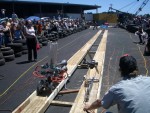
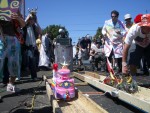
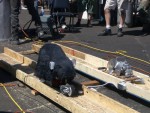
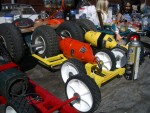
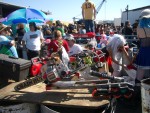

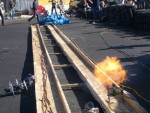
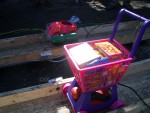
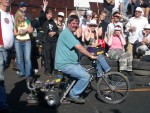
Niki de Saint-Phalle and Jean Tinguely would have been proud (they did the crazy, colorful fountain at the George Pompidou center in Paris and are probably the patron saints of all this stuff).
Here's an essay I wrote for Charlie Gadeken (of Qbox) last year, when he asked for a review of the 2003 event. It's a bit smug, but I think the description is still relevant.
A Carnival for Belt Sanders
There was a moment at this years' Power Tool Drag Races when one of the racers — a gas-powered saw thing with rubber tricycle wheels and a dented trombone for a muffler called Horned Devil — jumped the track. The wheels were probably designed to be big enough to keep the thing between the guide rails so that it wouldn't get turned sideways and drag itself to a halt, as some of the racers do. Nice idea, but that's not what happened. The problem was likely that the wheels were too big and had just enough grip on the rubber tread to grab the edge of one of the two-by-fours that make up the rails. This probably caused the other wheel, which was still on the ground, to push a little harder, turning the thing directly into the rail, which it proceeded to hop pretty effortlessly. Since the thing was gas-powered, the power couldn't be cut once it had left the starting line and it kept going in whatever direction it was last pointed at.So it made a beeline for the audience's legs. Ideally, the audience was supposed to keep their arms and legs behind a fence of old tires that separated them from the track. People, however, tend to take their mastery over technology for granted and the Power Tool Drag Race audience was as cavalier about it as their parents were on midway parachute rides and as their grandparents were when standing next to the big bull at the rodeo.
I was standing next to the track when the Horned Devil jumped the rails, and I could see the puzzled look on people's faces as the thing made for their legs. Having left their computers and cappuccino machines (who used which for work and which for entertainment is hard to tell in this crowd) and driven to Ace Auto Salvage in their electronic fuel injected cars and motorcycles, they at first seemed a bit surprised to see the thing coming at them. Sure they had to sign this waiver thing before going in, but that had been long forgotten in an afternoon of beer, sun and funny announcers. As their thoughts turned from "Cool! It's jumped the track!" to "Crap! It's going to eat my legs!" may be there was a moment of contemplation about our relationship with our domesticated technology, a shift in the attitude to the objects that surround us and which we take for granted.
I doubt it. In the seconds before a car crash no one reflects on their comfort zone in the balance between convenience and safety, and I doubt anyone was thinking of anything but getting their somewhat sunburned legs behind the tires. But it's kind of a nice thing to think about.
The funny thing about the Power Tool Drag Races is how little the racing mattered. Sure there were a lot of entries and there were all the trappings of a race (announcers, hot dogs, flag girls, stopwatches, a leader board, a bookie). Yes, toward evening Jim Mason's nitrogen fire extinguisher skateboard did 0-60 mph in about a second and beat out a hand drill on an RC car frame, weed whackers, circular saws, and the usual gang of sanders. As his grand prize, Jim now technically owns a semi-functional Edsel sedan. But that's not the point. Unlike the hardware store belt sander races for which basement tinkerers make their sanders a little faster every year to take out their neighbor in the parking lot of the local ACE and get a gift certificate and a trophy, this is different. In San Francisco it's not so much what you do, it's what you wear while you're doing it, and the drag race is no different. No one really complained that Jim was one of the founders of the race and that including fire extinguishers is kind of stretching the definition of power tools [nb: in 2004 they've changed the rules so that Jim's racer now fits in the rules and the RC car doesn't]. Only a few people seemed to bother trying to figure out how to get the most torque out of a leaf blower. It's unclear whether anyone even wanted to win the Edsel. Taken as a whole, the point wasn't the race, it was the drag.
And there was a lot of power tool drag. Freed from domestic drudgery, the power tools let their freak flags fly. From the Horned Devil to the belt sander slut thing to the Teddy Bears' Tragic Picnic to the thing that was only held together by jamming and wedging pieces to each other, it was an orgy of machine decoration, somewhere between performance and costume ball. Who knows what drove people to stick saws on skateboards and then spend days, weeks in some cases, futzing and decorating the things. What drives people to hang fuzzy dice from their rearview mirrors, to get silly cell phone faces. Why did kids stick cards in bike spokes and hang streamers from the handle bars? Maybe we want our machines to be a little more like us, so that we don't turn into them.
May 15, 2004
How did that happen?
It was supposed to be an appliance design conference, but there was this reception and there was champagne and, well, I don't really know how I ended up wearing a jester at Thornbury Castle...
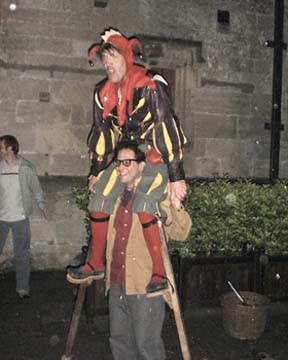
(thanks to Rachel Eardley for the photo!)
May 12, 2004
Smart Furniture Side Show
I've been bouncing around Europe, going to various conferences and hanging out with Molly. My brain is full of amazing impressions and my notebook is full of ideas. I'll (hopefully) be updating the site when I get to Ann Arbor toward the end of the month.
Today I'm at 2AD, the Appliance Design Conference in Bristol and it's really great. I'm doing the Smart Furniture Side Show, where I'm talking about my ideas and the second version of the Manifesto (which is going to be in the June issue of Metropolis Magazine--look for it!).
I'm also heavily relying on several amazing posters designed by some very talented friends of mine on very short notice: Ranjit Bhatnagar, Brady Clark,Terry Colon and Sonia Harris (who burned the midnight oil pulling everything together--thank you, Sonia!).
Here's Sonia's rendition of the v2.0 Manifesto, in glorious printable large format PDF to decorate your cube with (or throw darts at...whatever):
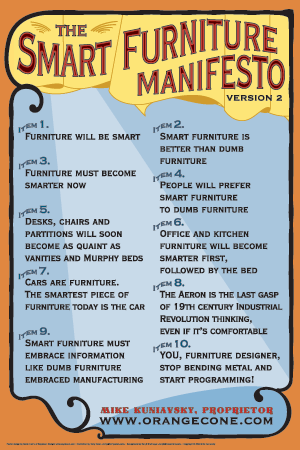
(290K PDF)
[Poster picture/PDF added 5/25/04]
April 23, 2004
Hinton reviews my book in Boxes and Arrows
Andrew Hinton writes a thorough and insightful review of my book. He was swayed by my suggestion that the tools of marketing research should not be thrown out with the bathwater of bad marketing, which I'm happy to hear, as it was one of my goals in writing the book.
Thank you, Andrew!
April 10, 2004
Why I left Adaptive Path
Last week I resigned from Adaptive Path, the user experience consulting company I founded in 2001 with Lane Becker, Janice Fraser, Jesse James Garrett, Peter Merholz, Jeff Veen and Indi Young. Resigning AP was one of the most difficult choices I've ever had to make. The company has been extraordinarily successful in the three years since we started it and is now the best company doing what it does in the world, on many levels. Exciting companies with large, interesting projects are continually knocking on the door and the ideas generated in our little Hobart Building office are some of the most innovative in the field. We've chosen to grow slowly and, as a result, have had the luxury to handpick the best people as our employees and consultants. It's a tremendous company and I'm immensely proud of it and of my partners.
The work that I am most interested in at the moment, the work that I have been most passionate about over the last year, deals with ubiquitous computing, ambient intelligence and smart furniture. I really wanted to get serious about this stuff, since it's what's exciting me most, as much as the Web excited me 10 years ago (yikes!). I wanted to pursue it and follow the ideas, and I wrestled with how I could meld these interests with the kind of work Adaptive Path does. Ultimately, I decided that it was not strategically appropriate for me to be doing this kind of R&D work inside AP, since it was a distraction for both of us while I was pursuing it inside.
So, with a heavy heart and anxiety about the future, but confidence that what I helped build at Adaptive Path was more than strong enough without me in an active role, I decided to move on. My partners and our employees have been incredibly supportive and I look forward to working with them again in the future, and I will beam proudly from the sidelines as they take the company to (as the saying goes in Silicon Valley) the next level.
Watch this space for more from me about my current interests and look for my article on smart furniture in the June issue of Metropolis magazine.
March 28, 2004
"Making Modernism"
It's so long that I've written here that it's embarrassing, and how I'm repurposing a halfbaked email I wrote to a friend. Blog shame.
On my recent flights I've been reading a lot of books, since all the travel has removed my--hitherto cherished--ability to sleep on all flights. Now I have to read, and I've been reading a lot.
One book was Making Modernism by Michael Fitzgerald, which analyzes Picasso's career as more than just an artistic achievement, but a key entrepreneurial one that became the archetype of artistic careers throughout the 20th century. The book is, frankly, boring, (the art historical version of the begats: "Then Picasso had this show, which had these paintings...and then a couple of months later, there was this show which had THESE paintings in it...") but it's a fascinating story to see how Picasso and his dealers (and, in the 30s, the Museum of Modern Art) carefully managed his image, cultivated his relationships and played the art market not just to maximize prices in the short run, but to brand him--in the modern marketing sense--as "The Greatest Living Artist" for most of his career after his 30s.
It's quite remarkable and it's not clearly not just that Picasso had the chutzpah to proclaim himself as such and have some gut-level savvy coupled with luck, but that he carefully managed his reputation (and his contacts, and his image--while he and Paul Rosenberg carefully controlled his inventory and the prices for his work) to make the most of his position at all points. He was an active shaper of his reputation, dispelling all of the art-for-art's-sale mythology of the French Academy and taking the final step to bringing his art to the open market as the Impressionists had wanted.
From a corporate standpoint, it was a classic CEO-CFO marriage: he was the CEO, whose job it was to maximize revenue in the long run through innovation and brand-building; while Rosenberg was the CFO, maximizing profit (which generally means controlling costs and carefully pricing). There's an interesting story in the book about how worried gallerists--especially Rosenberg--were after WWII as government started auctioning off large quantities of 1930s Modernist work that had been confiscated by the Nazis from Jewish dealers; the worries came true and the auctions depressed prices for Picasso's paintings until the late 40s because everyone who wanted a Picasso was able to get it at bargain prices right after the war.
It's also interesting to contrast Picasso to Duchamp. Duchamp is the Steve Jobs to Picasso's Bill Gates (and Rosenberg's Steve Ballmer?) and he was never able to achieve the same level of market penetration or popularity, despite the fact that he was the more innovative and radical by far (at least when their careers are compared after Cubism). Duchamp's brand identity rested on constant radical innovation, which is a much more difficult position to maintain than Picasso's, which was mainly built on being consistently Picasso. Picasso had to produce interesting work that was understandable and appreciable by his target audiences, and in sufficient quantity to keep interest high but without overheating or alienating the market, which is a much savvier position.
It's fascinating to take the Picasso archetype and look at how other artists and working the artist-gallery-museum ecology to manage their careers. Warhol seemed to understand this, but he did not understand it as well as Picasso. Jeff Koons made the game so apparent that the other players may have burned out on it. Matthew Barney's career seems like a particularly sophisticated example, the high art equivalent of a boy band (or maybe just Justin Timberlake). (And that's only bad if one insists on the platonic purity of art as strictly self-expression and a way to actually make a living.)
February 17, 2004
The Broken
So I've recently been playing a fair bit with BitTorrent and I noticed a torrent for a new episode of The Broken a video hacker zine.
It's been almost 20 years since I did the community access video thing, but, damn, these guys really put out a professional looking product. A suspiciously professional-looking product, in fact. It's fun and funny, but it's softcore hacking at best. Subversion Lite. They don't say much that's actually controvertial or give any instructions that are likely to get them in trouble, and they bleep out the swear words. It seems almost like an audition tape for TechTV. If it is, it's a great audition tape. If it's not, maybe it's a TechTV plant (or some other major organization), getting street cred before these guys are miraculously hired and given their own show. Or maybe it's Fox testing out BitTorrent for scalability as a content delivery system. Maybe it's even just these guys actually doing this on their own, but they've been so indoctrinated by TV that their stuff looks like it should be fake (in which case I suggest they drop the half-hour format and the Screen Savers framing devices and hax0r the whole idea of a TV show).
Regardless, it's clever, well-made and I was entertained.
February 15, 2004
ETech Zeitgeist
Last week Molly and I were in San Diego for O'Reilly's Emerging Technology Conference, where Molly and Michael Kieslinger's did a highly-lauded Fluidtime presentation. I'm sure it's been overblogged and superwikied, so I won't belabor the details, but I did have a couple of observations of the trends I noticed in the conference, which could be trends in emerging tech, or maybe just this group.
- Social Networks as access control. With the practice of discussing social networks as the next big thing kind of coming to a close, people are starting to discuss what they're for, after they've been populated. A number of dicussions basically boiled down to the idea of social networks as the new access control list. Social networks allow me to use a quick shorthand for who should see what of my information.
- Document sharing was also big, with various groups presenting all kinds of clever ways of interchanging documents, often coupled with social network access control. So look for new services such as Flickr (from the fine folks at Ludicorp, who would are in my social network). Personally, I want something to merge BitTorrent, Orkut and Allmusic with iTunes so that I can listen to the stuff that my friends have in their music folders.
- Geeks working for the army. This was a weird one, but there were at least three sessions (from iRobot--the Roomba people, JC Herz--of Joystick nation, and icosystems--a splinter of the Santa Fe Institute studying emergent behavior) that had people really focused on, and being funded by, military applications. That's not surprising, since a lot of tech gets dough from the Army, but it was surprising at this conference. There seemed to be little introspection or remorse about it, though there was some guilt. As much as I believe in the inevitability of conflict and that keeping our soldiers safe is important, these technologies worry me. I believe there's currently a military culture that aims to disassociate itself from the human side of war and treat war as a hygenic process, where reducing the messiness makes it somehow less contagious. I think that's a bad metaphor, one that's gotten us into trouble in Iraq and will again. Creating technology that further mediates the process makes it easier to avoid the learning that's important to creating peace.
That last concern apart, it was a great conference, if only for all the hanging out in the lobby bar. I think having it in San Diego, away from the Bay Area where people felt comfortable and could leave at night, was a good one. It made everyone stew in the same juices for a couple of days and although I'm now exhausted from all the socializing, it was well worth it. I will now know to prepare for any conference that has lots of social network and mobile technology participants: the combination of highly social people with lots of cutting-edge mobile technology in a town that no one really knows means dinnertime decisionmaking paralysis on a scale like never before.
Oh, one last random thought I had there, which mixes scientific metaphors in an attempt to explain Howard Dean's success and subsequent failure: it was because of a combination of first mover advantage amplified by a highly networked environment (the media). It seems analagous to a forest fire in August. A spark in a fuel-rich system that has no inherent controls, it reacts strongly, but the strength of that reaction can distort any examination of the underlying landscape. When the initial fuel burns away, it reveals the layer beneath it, which may or may not be able to support further growth.
January 22, 2004
Social Origin of Good Ideas
I'm reading a fascinating paper right now called Social Origin of Good Ideas (PDF) by University of Chicago professor Ronald S. Burt. It's an analysis of how, to paraphrase, exposure to different fields creates the opportunities for good ideas and how that makes people more successful. His research is thorough, readable, appropriately interdisciplinary and it's a fascinating application of social network analysis. Most important, however, is that it validates my dilletantism. ;-) Here's a chunk of the abstract, which describes the gist of the paper:
The hypothesis is that people who live in the intersection of social worlds are at higher risk of having good ideas. Qualifications come immediately to mind, but the gist of the hypothesis is familiar in sociology and makes intuitive sense: ways of thinking and behaving are more homogenous within than between groups, so people connected to otherwise segregated groups are more likely to be familiar with alternative ways of thinking and behaving, which gives them the option of selecting and synthesizing alternatives. I describe anecdotal and aggregate evidence consistent with the hypothesis, but my goal in this paper is to study the hypothesis in finer detail, at the level of individuals, to talk about ideas as a catalyst for the performance effects of social capital.
I saw this referenced in Strategy + Business magazine, but I find it interesting that the study of multidisciplinary thought and social networks is starting to filter through to the popular media. Social networks, of course, have been a big meme since Friendster broke, but the interdisciplinary nature of the current intellectual environment is a relatively new thing, I think. I've had a bunch of conversations lately about it with Ben, Danah, Molly and the rest of the usual intelligentsia (and, for the record, I'm not going to let the topic fold in on itself--yes, my social network of interdisciplinary intellectuals is dicussing social networks of interdisciplinary intellectuals, move along), so it's probably an interesting thing.
Where this current interest comes from? For those of us who grew up in the rampant relativism of the 70s and 80s there's a kind of intellectual vertigo. I've often heard people talk about being starved of anchors of certainty in their lives. The ephemeral nature of Internet work (maybe modern creative work in general) only serves to reinforce it, forcing people to seek ever more extreme ways of grounding (Burning Man? knitting?). Lately, interdisciplinary ideas seem to have escaped places like the Santa Fe Institute and the Global Business Network to become more generally popular. TED-like conferences and university programs seem to have appeared much more frequently than I remember 10 years ago. Maybe this is the escape that people have found from the anxieties of perennial doubt? Narrowly-focused Modernist certainty (which extended from narrow job definitions to the coining and following of successive art movements) was undermined and followed by an age of ever-deeper uncertainty (i.e. the 70s and 80s), which was deeply anxiety-inducing. But maybe the end of the Cold War inspired enough optimism that people managed to look for and find a new kind of anchor by looking in several places at once? Maybe the Web resonated with this need and accellerated it? Or maybe I'm just projecting justifications? (I'm certainly rambling.... ;-)
Maybe. For now, it's interesting to see that someone is studying it.
January 11, 2004
Lichter/Distant Lights
The Berlin and Beyond film festival is in SF and Ben and I went to see one of the films last night, Lichter (or Distant Lights in English, here's a synopsis). It was in much the same genre as Traffic. That film's tagline, "no one gets away clean" can apply here, too. What's different about this film is that rather than trying to tackle the problems of the central narrative element--smuggling people and cigarettes across the German-Polish border--head-on, it tells a more subtle story about human frailty, need, trust and betrayal. The characters, and there are many in its six (five? it's hard to keep track) parallel stories are all more than the roles they play. Traffic, an excellent film, made its characters iconic, representational of the roles of people in their position, and so made them statements in a debate on drug smuggling. Distant Lights doesn't seem to want to debate policy, it's much more concerned about how the situation, the border, forces people to confront themselves, their aspirations and each other. In a way it's a pretty serious downer of a film, since it provides no answers and--frankly--doesn't even articulate any questions, but it's a really powerful statement about what it takes to make choices and how contingent our choices are. As filmmaking, it's one of the most subtle, well-edited and tightly-written films I've seen in a long time and I highly recommend it.
December 29, 2003
Holiday Travel & Disease
Traveling to Minneapolis to spend time with Molly's family, I realized why holiday travel may be one of the most dangerous activities we engage in as a culture. It's the potential for disease transmission. Holiday travel brings together three things that individually increase how much airborne diseases get transferred:
- Population movement. The point is to move around a lot.
- The cold and flu season. ...at a time when diseases naturally peak.
- Children. ...with kids, who have developing immune systems, and so are more susceptible to various diseases, thus more likely to be contagious.
Now, this is not to say that holiday travel is a bad thing--I had a very nice time in Minneapolis (where the highs were about what the lows in San Francisco are, but where the buildings are so much better insulated)--but I found it amusing that somehow our world had managed to find a way to bring together three of the most likely disease-causing factors into one. At no other time of the year are all three of these factors true. I wonder what the economic impact of this is. One the one hand, people are spending a ton of dough on presents and plane tickets; on the other, many are going to get sick and be out of work for some period of time after the holiday. How does it balance out?
December 06, 2003
Matt Gonzalez day in the Mission
It's mayoral election time in SF and for the first time in many years there's a challengers to the Democrats. Not surprisingly, this being San Francisco, the challenger, Matt Gonzalez of the Green party, is from even further left (or at least presents himself as) than the Democrat, Gavin Newsom. The classic Buffalo Springfield's lyrics are quite appropriate in the Mission today:
What a field-day for the heat
A thousand people in the street
Singing songs and carrying signs
Mostly say, hooray for our side
And, apart from the "heat" part, since it's neither hot nor are the cops out in force, it's a classic San Francisco self-congratulatory celebration. Not that there's anything wrong with it, but maybe some of these signs--and at least one of the several Gonzalez-elegizing guitar-toting troubadours who were walking through the Mission--could have been better placed in parts of the city that Gonzalez is not sure to win.
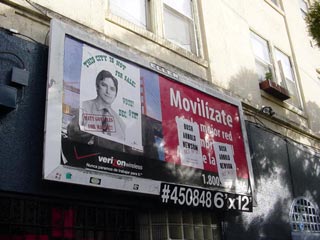

Frankly, I'm pretty happy about it, too. Both of the candidates are young, smart and reasonable. I think that Gonzalez is more reasonable Newsom in enough things that I'm voting for him, but I think the city wins in the long run with either one.
December 05, 2003
Grafarc.org launched
My good friend Cassidy has been taking pictures of graffiti for years. A couple of years ago he realized that he had taken pictures of the same piece of wall many times, with many different pieces of graffiti on it. So he started a project to unify all of the pictures of all of the walls he's photographed and allow someone to peel back the layers and see how a wall "learns" (in the Stewart Brand sense) based on the graffiti that's on it. After a year of pretty intense effort--a lot of perspective correction and painstaking matching of photographs that were not meant to be matched when taken--the project is up at grafarc.org and it looks great. Go Cassidy!
December 01, 2003
Contemporary Art and Obsessive Compulsive Behavior
So although I spent the last couple of days looking at Renaissance art in Florence with Ray I've been thinking about contemporary art (among other things). One thought that has been floating around my head for years now is that the contemporary art world rewards obsessive-compulsive behavior like not other single psychological trait. Why?
My pet theory is that art history is caught in a paradigm where it's looking for trends, styles or common theme indicators, even as those ideas have become more-or-less meaningless since Pop (at least if you agree with Arthur Danto, which I generally do). Pop--which, really, was a reaction to the exhaustion of Abstract Expressionism--neatly erased the notion of a dominant style. However, people (art critics, curators, etc.) are still looking for things that will give meaning in an era without a dominant style to compare with. So, in an attempt to try to find some meaning in the art that's crossing their view, many curators and critics have latched on to repetition as a proxy for vision. This is not necessarily wrong--there can be a beauty and depth in repetition (Donald Judd and Agnes Martin are particularly good at this)--but it's led to a lot of lame art that's just repetition for repetition's sake, obsession for obsession's sake.
So, in light of this, I'm updating the old art school maxim:
If you can't make it good, make it big;
if you can't make it big, make it red;
if you can't make it red, make 50 more.
November 24, 2003
Berlin
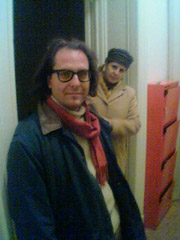
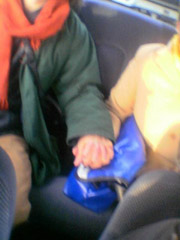
Pictures by Joerg Bloem and Katja Grubitzsch (from a phone that takes really good digital pictures--these are about 1/3 of the full resolution)
November 21, 2003
Motorcycle Clothing
While shopping in Milan we bumped into a display of motorcycle gear by Tucanourbano, an Italian motorcycle accessories company. They have a line of cute and ridiculous helmet ears that I like, but they also have a line of passenger leg covers/bags which led me to think that there's got to be a market for easily attachable-removable "clothes" for motorcycles. There are lots of fur-coverd motorcycles and scooters at Burning Man every year, so it's eminently doable and--unlike other customization--it's cheap and removable. I bet there's a business in this, somewhere, and someone should start it. Not me, but someone.
October 10, 2003
Another review!
My book was reviewed by Christine Wiegand for the SAP Design Guild. She liked it and said it was long. I'm glad about the former and can't argue with the latter. ;-) She liked the practical aspects of it and correctly identified that there should be a shorter description of some of the techniques. I agree and I've thought that there's a place in the market for "The Guerilla Guide to User Experience Research."
In the interim, please note that the book is written so that pieces of it can be read without needing to read the whole. It's designed to be used like a cookbook, rather than read like a novel.
October 09, 2003
Scanner Disco Floor
Random idea of the week: a disco floor made of scanners. I was walking down the street on Monday night and saw a scanner sitting on the street. Technology is tossed to the curb all the time in San Francisco, and lately I've been seeing more scanners (for a while it was managed switches) showing up the trash. This led me to think "Hmm, what could you do with a bunch of scanners?" and the idea of the scanner disco floor emerged.
Picture a floor with constantly moving back-and-forth lights, making long streaky scans of people's feet and ankles. The images could then be used in a video wall. Imagine if someone was breakdancing over this floor, or making snow angels. I think it would look great. There's already a whole camera-less scanner photography movement (as beautifully exemplified by Kevin Lyons' Floraphilia site). This could be the equivalent of scanner video.
I looked into it, and and the Linux scanner drivers can support up to 100 simultaneous scanners, which is a 10x10 grid and should be enough for a decent sized dance floor, or a corner of one. Of course people couldn't actually dance on the scanners themselves, but if you placed them directly under some hard plexi, maybe the depth of field would still be good enough to get decent results.
September 28, 2003
Moved!
The blog has been dark for a couple of weeks, and for that I have blog guilt. Not too much guilt, however, since 1) it's my damn blog and 2) I've been genuinely busy.
One of the things that took up a bunch of my time recently has been the move to a new machine. After the recent traumatic downtime experience, several 3AM power outages and a mysterious network outage that had my ISP and the DSL provider first pointing fingers at each other and then at my router (which was conveniently out of warranty), I decided it was time to move. It's a little sad, since this may be the first time in a decade that there won't be some kind of email/web hosting happening out of this house (thanks to many years of Cyborganic servers here), but it was time. Among other things, the economics no longer make sense: I had a business class SDSL line that gave me about 1/3 of the bandwidth for 3 times the price of a consumer ADSL connection, which is silly even there is some kind of vague guarantee of bandwidth availability and a couple extra static IP addresses. I'm willing to live with the tradeoff, so it was time to move.
I was fortunate to have found a bandwidth cooperative with a data center rack and even more fortunate when one of its members expressed interest in selling a machine that was already in the rack. So I bought Brian Ng's box "as is, where is" and enlisted my old friend David Fred to help me with the move. Used to be, you enlisted your strong neighborhood friends to help you carry stuff into your new apartment in exchange for pizza and beer. David, who is a titan of the network world (just look at his resume!) helped me with the heavy intellectual lifting move from across the country in exchange for disk space and bandwidth. Even so, I think it took about three times as long as I would have predicted (with the move of this blog taking up a surprisingly long time—I'm, frankly, amazed that the Movable Type blog moving process is so involved and, considering how well-designed the rest of the application is, so—uh—manual).
Anyway, the new machine is up and running, honored to be sharing rack space with a number of famous domains.
September 10, 2003
A book review
Ian Alexander reviews my book and I like his review (and not just because it's positive ;-). He's completely accurate in describing my intentions with the book:
[...] most if not all the techniques he describes apply as much or more to systems of all kinds. Indeed the father of industrial design, Henry Dreyfuss (he of the standard bell telephone and the Hoover vacuum cleaner) applied the same principles in his pioneering work.
I chose to limit my subject matter to that which I had the most examples from (which is what I had the most experience with), but I'm a firm believer in the universality of user research as relevant to all design, not just software or the Web.
Thanks Ian!
[9/11/03: Ian is the co-author of Writing Better Requirements, which looks to be a very useful addition to that (regrettably) often quite necessary practice.]
Property Disposition
I was visiting Ann Arbor over the last couple of days. My parents live there and I went to school there. It's a cute little town if it wasn't so small and so cold. It also houses of my shrines, one of the most important and resonant places for me, the University of Michigan's Property Disposition. Property Disposition is a strange kind of university organization. They get rid of stuff that the U no longer wants, but which still is perceived as maybe having some value. All stuff counts, whether it's a shelving unit or an electron microscope or a dishwasher. Many large organizations solve this problem with big auctions in which whole pallets of semi-random stuff are sold to local junk dealers and to reps from other large organizations. A pallet with a desirable camera lens may also have a baby incubator and a box of cleanroom booties along with it. Property Disposition is different: it's open to the public and stuff is individually priced and parted out. This makes it one of the best garage sales in the universe, and an ongoing one at that.
To me, it's also a museum and an amusement park, a puzzle and a game. For 15 years I've been going there whenever I can (which nowadays means once or twice a year, but it used to be once or twice a month) and looking through the stuff that's in the warehouse. The stuff constantly changes since Property Disposition's job is largely to empty the warehouse as quickly as possible, so there's always something new. What's there are the products of the material culture of science and medicine: microscopes, meters, centrifuges, specimen cabinets, strange boxes, examination tables, grey Steelcase desks and lots and lots of computers. Much like Ebay is, to me, the most important repository of material culture information about America, Property Disposition is—taken through time—the ongoing documentation of the history of American science in the later 20th century.
It's also science artifact purgatory. It's the last place that much of this stuff is still in its original condition as an instrument. Sometimes the stuff gets a second life in some other university role (U departments get first crack at it), but more often than not when it leaves, it leaves to either be remade in some industrial capacity, as a personal object, or, as is often the case, as junk. Behind Property Disposition are two big dumpsters: one has things that have metal in them, this goes to a metal recycler; the other, things that don't have metal, this goes to the dump. I used to dumpster-dive the recycling container nearly every week, pulling interesting-looking technology from it. For a while, I had a Saturday decompression ritual: I would go to Property Disposition, pull out some interesting-looking piece of technology from the dumpster, and then spend the afternoon disassembling it while listening to the Down Home Show. It was a meditation on the objects. I learned a lot about how things are made and, most importantly, it was a way to honor the objects and all the hard work they embodied, to rescue from them one final bit of knowledge before I took the disassembled pieces back and tossed them back in the dumpster. The products of technology are so emphemeral, despite the fact that they're made out of rock, metal, glass and plastic, that something in me felt they needed one final send-off.
Sadly, the quality of the objects has changed as science has changed. The full-on Frankenstein Esthetic faded in the early 90s as handmade custom designed machines (often in wooden crates with brass hinges, unlabeled dials and hand-soldered hardware) gave way to general-purpose computers, but you can still find pieces that echo the jerry-rigged, messy way that science was conducted, before all of that became hidden in lines of code and databases, and I still get a rush from it, from trying to figure out what did what and how it all fit together.
This last trip there were three things of note:
- Two Ardent Titan computers. Graphics supercomputers from the early 90s. Probably $200K apeice when bought (and a bargain at that). The company was never very big and merged with Stellar (to form Stardent), which also closed down quickly, so these may be 20% (or 50%) of the ones that still exist. These seemed to be complete, with monitors, keyboards and hard disks. Ironically, it's the mundane stuff that's sometimes the biggest problem with rescuing old machines: a mundane-looking cable can be so proprietary that it'll cost as much as the rest of the hardware to get one. I almost bought the one they had about a year ago that was missing the monitor and disk for $150, but then I realized I'd just have to put it in my parents shed, and there's a PDP-4 there already that they're none too happy about. $250 apiece.
- Two TRW view cameras of some sort. Looked to be from the 70s. Big things that looked like video cameras, but had view camera lenses and shutters and Polaroid backs. Triggered electrically. One had "NUCLEAR" written in fading marker on the side. I can only imagine what these took pictures of (particle traces?). $100 apiece (probably worth five times that just for the fast lenses and shutters).
- A bunch of Cabletron MMAC cabinets. These were rackmounted Ethernet and fiber switches from the early 90s. I remember when the university was buying 'em for lots of money. They presaged the whole Net boom, the crazy consolidation in the industry (I think Cabletron got bought by 3COM) and the collapse. When they were bought, it was because the U realized that bandwidth needs were growing and it needed to keep up (well, OK, maybe there was more of a plan), not because devices like these were to become the foundation of a massive cultural shift 5 years later. I think they were $15 apiece.
I rarely buy anything there, though, since I have too much stuff already, but I'm already looking forward to the next trip.
August 25, 2003
Focused chaos
Excuse the meandering nature of this post, but Molly and I are frantically preparing for Burning Man, for which we leave tomorrow (stop by Dogma between Received and Serious if you're going to be out there).
This is the first year that I'm not going to be camping with a theme camp. It was the bianca life for many years and last year we camped with Ray at Airstream Court, the airstream camp. This year we were going to camp with the Airstram folks again, but at the last minute we decided that the suburban life wasn't fast enough (Airstream Court, and Ray: we're sorry to have only told you at the last minute! We'll make it up with food!). We may be in our 30s, but we're still largely living the lives of 20 year-olds and we might as well revel in it while we have the chance. So we're camping with a Friendster cluster of other 30 year-olds including Lane, Courtney, Mule Design, Moses and Lucie, Adam and Nurri and several other Friendster clusters.
On that note, I heard an Eva Zeisel lecture earlier this year where she responded to a question about how it felt like to be 96 years old by saying that she didn't know: she had always thought that she'd grow up, but she never really did, she just grew old. That's inspirational. Perspective and restraint should accompany age, but fear of novelty should not. That said, maybe Burning Man has worn off its novelty for me, after so many years? We'll see how I feel a week from now.
August 20, 2003
Killed by SpamAssassin
Today I had to reboot flotsam, my server and the machine that gets my email, runs DNS and all my web services. It was a strangely traumatic experience. The machine had been up continuously for two years (586 days to be precise) and the hardware is sufficiently questionable that there's a chance that it won't come up after a reboot.
However, in addition to the expected dread of having to figure out why the flaky PCMCIA ethernet card wasn't being recognized and the sadness of losing the cool long uptime count, were the chills down my spine and the complete complement of fight-or-flight reflexes. It was the classic feeling of being naked on the inside, like when you can't find something that you've grown attached to and it felt strangely visceral and scary (and was followed by an equally-inappropriate level of happiness when the thing rebooted with no problem).
That led me to thinking about how physical distance and dependence are not necessarily related. Sure, a lost cell phone or watch makes you feel naked, but my mail server sits in a hutch in the hallway and I interact with it physically only every couple of months. The relationship seems more akin to that with another person, rather than a service and that seemed odd (although describing it this way it seems a lot less odd--people get attached to all kinds of stuff, but it was still interesting to see it happen in my own attitudes).
Anyway, now everything is back up and running. Whew.
(oh, and to the title of the post: I had run the SpamAssassin Bayseian network learning utility on my many-meg personal inbox, which caused it to suck up a ton of memory, which in turn caused it machine to thrash so hard that not even the login process worked)
August 14, 2003
First post!
So I'm going to make this short, and it'll probably more stiff than it needs to be.* I'm starting this blog for several reasons:
1) because everyone has a blog at this point and dammit I don't want to be totally behind the curve
2) because I've had the domain sitting around for years and I should do something with it and, most importantly
3) because I've had a bunch of ideas in the recent past that I'd like to get into a semi-public forum to test them.
And, sure, there are plenty of outlets for getting feedback, but I wanted a forum that I felt was my own.
So I'm planning to treat this as a somewhat edited and more thought-through version of one of my notebooks, which I've kept for years but have neglected to do anything with and which I've never really shared with anyone.
The topics I'm interested in discussing at the moment include:
- Smart personal technology. The things that surround us which are becoming smarter every day, including the underlying technology that is going to drive this.
- Smart furniture, because I think that's going to be a huge element in a near-future intelligent environment.
- The social, economic and political implications of all of these changes.
- Me, because--hell--it's my blog.
Anyway, that's the manifesto, on to the experiment.
*=Short and stiff, maybe that describes me, though I hope not.




